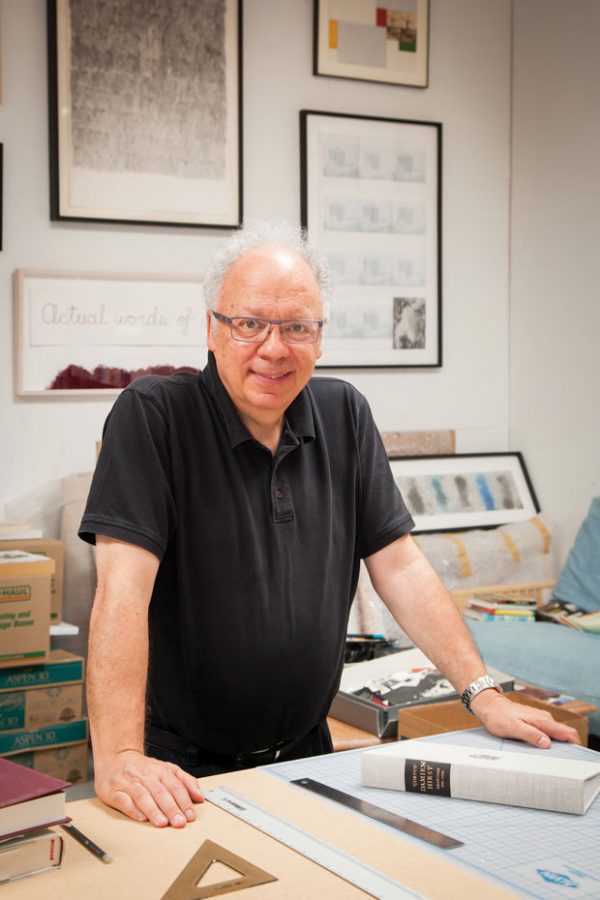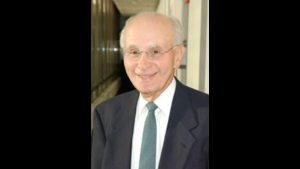Artists’ ‘New Work’ draws from books and jackets
Published August 27, 2014
If you hear the term “book art,” you may think of scrapbooks or artists’ journals. Artist Buzz Spector, a professor of art at the Sam Fox School of Design & Visual Arts at Washington University, has taken this term far beyond ordinary expectations.
Spector’s upcoming exhibition, “Buzz Spector: New Work” at Bruno David Gallery, includes collages, found images and altered books, all based on the concept of making art from books.
The artist’s collages of found poems feature lines of text he cut from book jackets and pasted onto handmade paper.
ADVERTISEMENT
“I consider every poem to be a found poem. We all use the same words,” says Spector, 66. “By ordering words and giving them emphasis and perspective, we reawaken something new.”
Each collage comes with its own theme. All of the lines in “Praise for The Calligrapher” are cut from critics’ book-jacket commendations. The poem’s lines are made up of the words “Praise for” and the title of each book: “Praise for The Calligrapher / Praise for The Crooked Letter / Praise for Finding Our Tongues …” The references to writing and reading, and the repetition of words, encourage a meditation on the appreciation of books.
“The title for each piece comes from the phrase or word in the upper left-hand column,” Spector explains. He starts with the first line as the theme for the poem and chooses subsequent lines accordingly.
ADVERTISEMENT
Spector has been fashioning art from books since 1981 but did not consider incorporating book jackets into his art until recently.
“It took a while for me to realize the jackets themselves could be used as art,” he says.
Now he looks for volumes with jackets or inside-cover text that interest him.
Jacket photographs of the authors play an important role in Spector’s art as well. He incorporates these into a piece titled “Frieze,” a 60-foot-long arrangement of author photos. Spector avoids celebrity author images but explores the notion of fame in other ways.
“There are lots of faces viewers don’t recognize, even if they have read the author’s book,” he says.
Spector arranged the photos, a mix of black-and-white and color images, in a whimsical manner. The figures at the far right of “Frieze” look to the right; those on the far left look left; and those toward the center look at the viewer. Their arm and hand positions (crossed arms, folded hands, chins resting on fingers) seem to repeat because there aren’t very many different ways to pose in author photos. Spector created “Frieze,”in part, to satirize the conventions of these images.
In addition to collages and found images, Spector presents a pair of what he calls altered books. He tears every page incrementally to produce a wedge-shaped cross-section of the book. The last page is the longest, left nearly intact, and the first page is mostly torn away.
“I think of the page tearings as thick drawings, or drawings in disguise,” he says. “This technique requires a book with an interesting concept and an attribute that becomes manifest if all pages are torn incrementally.”
One of the altered books, “Efface Nabokov,” is crafted from a publication of Vladimir Nabokov’s outline of his final, unwritten novel titled “The Original of Laura.” The author outlined the novel on notecards but passed away before he started to write it. This publication features facsimiles of the front and back of his notecards.
The title of Spector’s piece comes from the first word (“Efface”) in Nabokov’s handwritten list of synonyms for the term effacement, reproduced on the cover of the publication. Spector has torn the pages in such a way as to reveal what appears to be the image of a whole notecard. Upon closer inspection, the image is a composite of many notecard images printed throughout the book.
“I feel terribly guilty about tearing up books,” Spector admits. “I grew up in a house where they were semisacred.”
As a means of providing education and the acquisition of knowledge, books hold great importance in Jewish culture, though this hasn’t stopped Spector from creating his art.
Spector’s work possesses a greater connection to the overall history of Jews.
“The books I’ve altered have lost their origins, which can be seen as a metaphor for the condition of being Jewish,” he says. “Recovery of the original book is possible, but not easy.”















